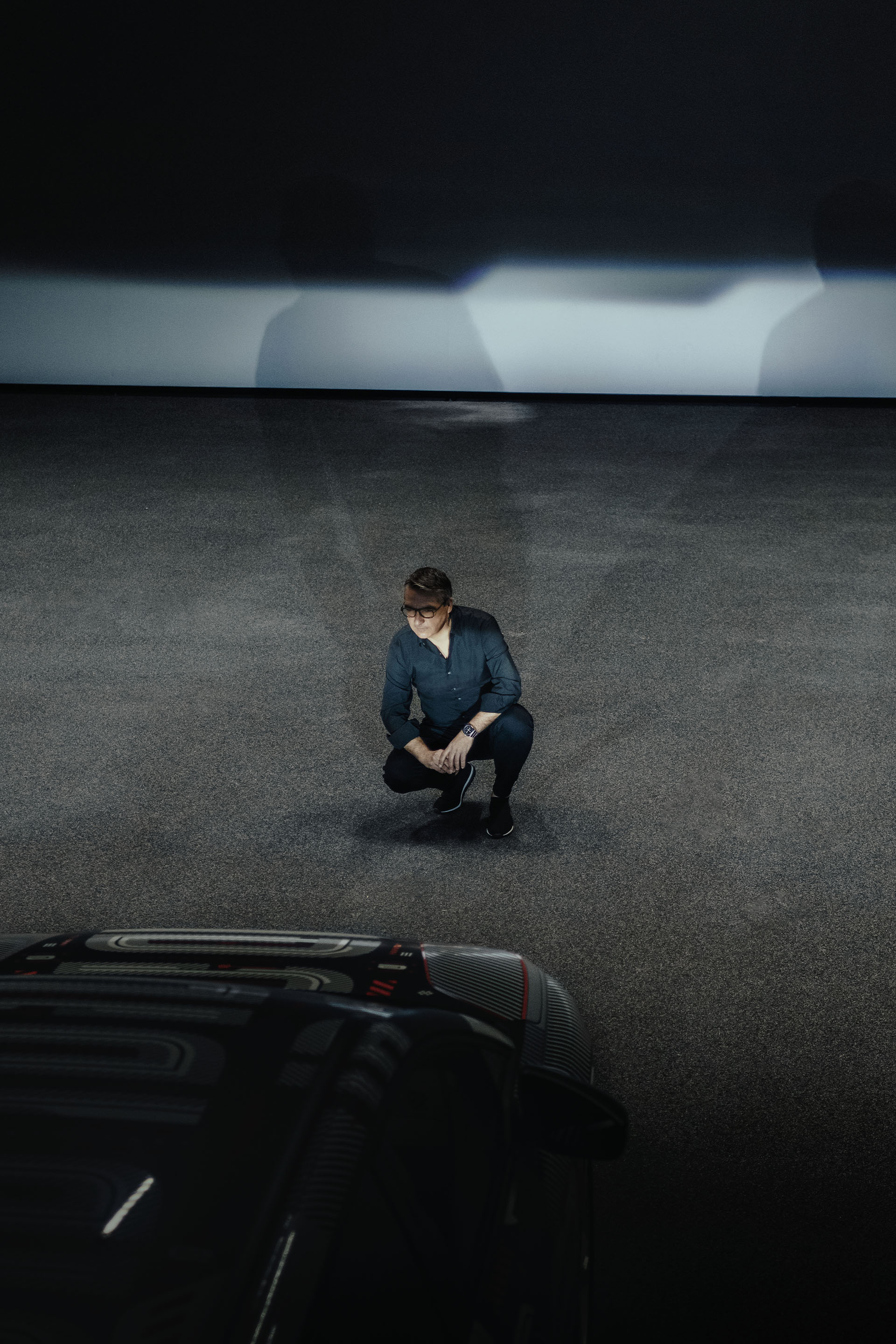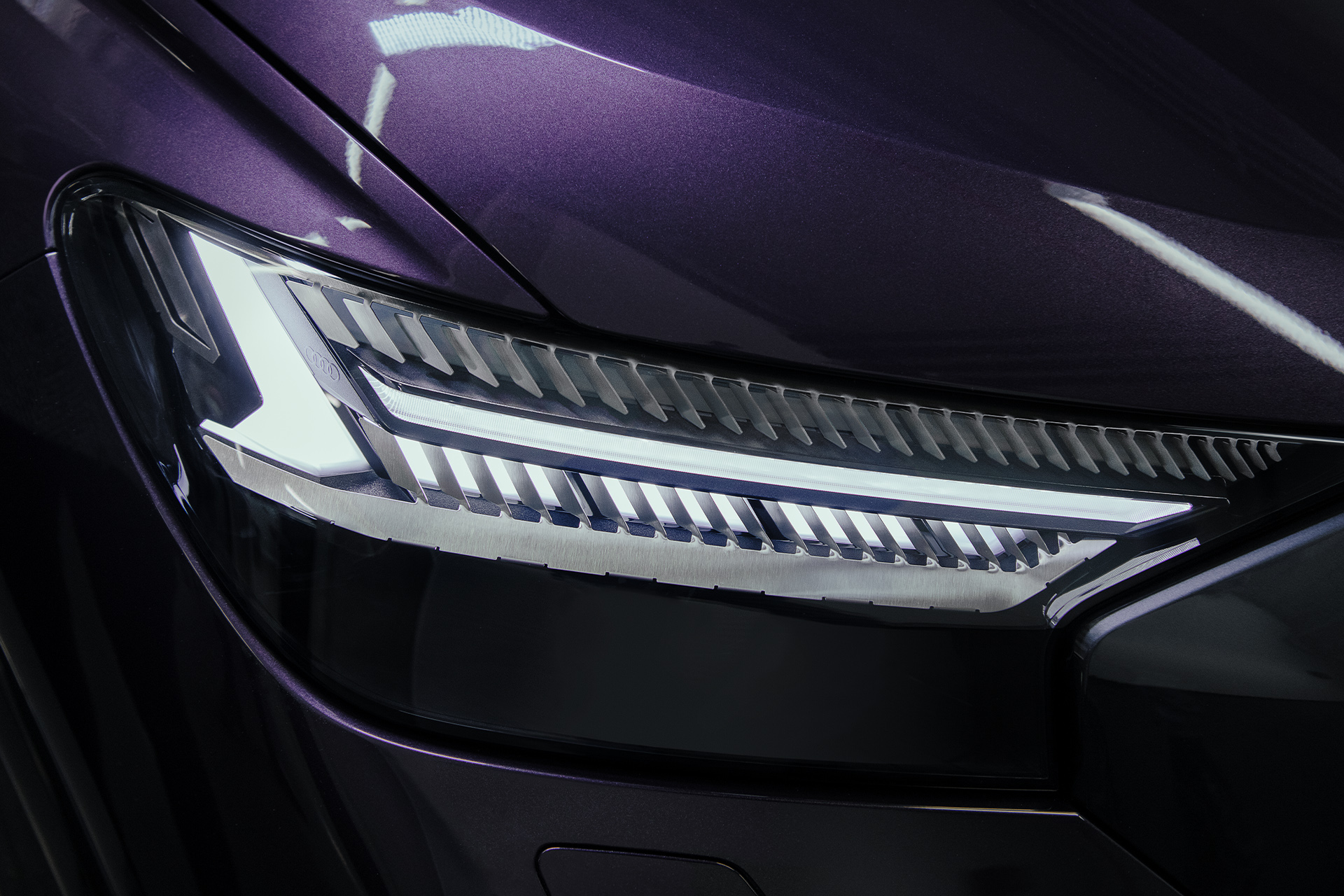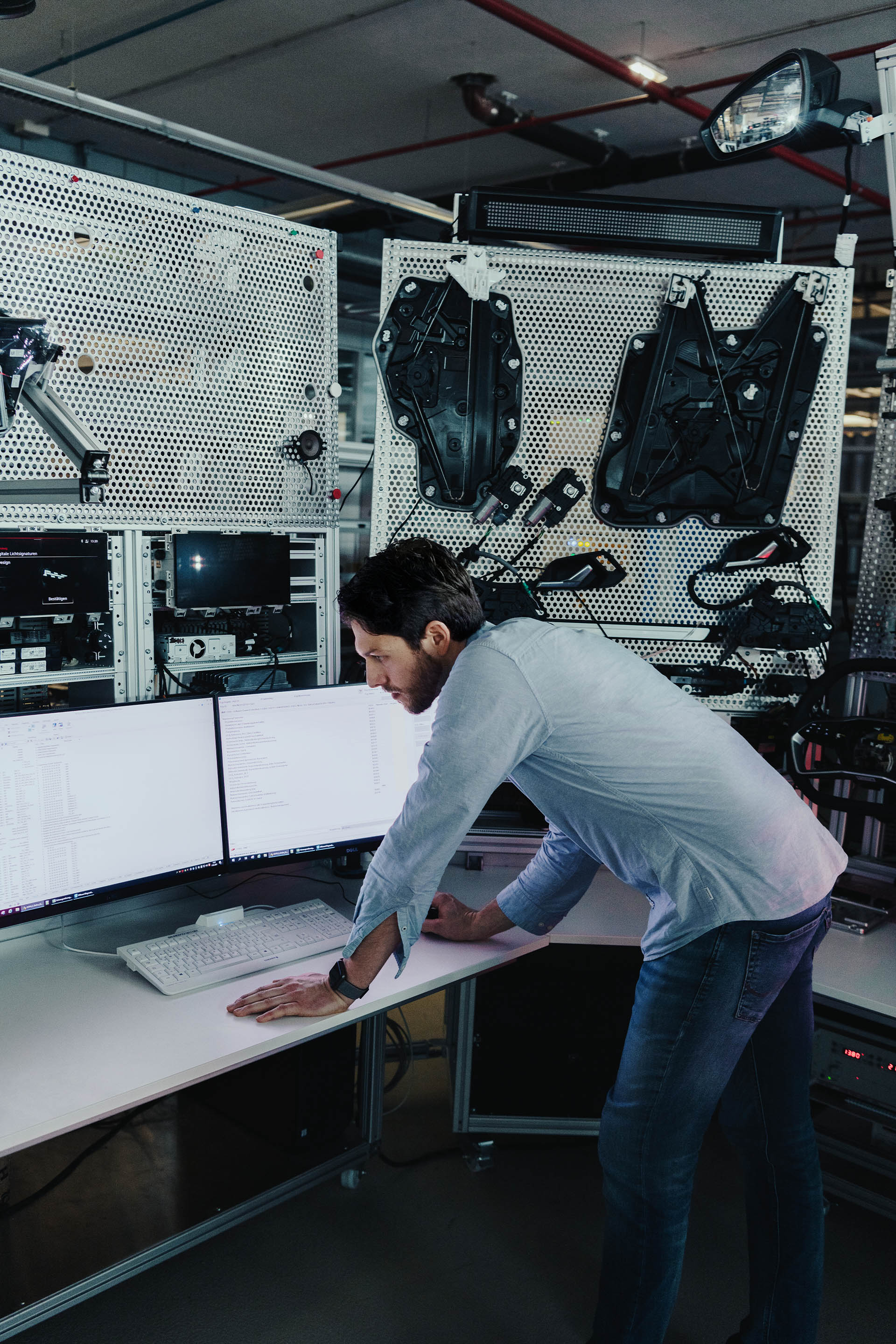Light as a means of communication
The Audi Q4 e-tron’s new digital daytime running lights are customisable and display dynamic light sequences that communicate with the onlooker.

César Muntada crouches down and looks straight into the Audi Q4 e-tron’s headlight. It really does seem as though the two are facing each other eye to eye: “After all, people always look each other in the eye first when they meet. And that’s the kind of relationship we also want to forge between vehicle and onlooker. The headlight design must arouse the urge for dialog: I see something and want to know more about it.” César Muntada, Head of Light Design at Audi, is looking to stir emotions through this relationship. “Meaningfulness, a sense of discovery, perspective – whenever we develop anything at Audi, the focus is always on people. We aim to capture people’s hearts with the design and functionality of the lights on the vehicle.” We are in Ingolstadt for a site visit to talk about the future of light at Audi – and the new Audi Q4 e-tron.

César Muntada, Head of Light Design at Audi, is looking to harness the vehicle’s headlights to forge a relationship with the onlooker.

The headlight is the eye of the Audi Q4 e-tron.
César Muntada, Head of Light Design at Audi, is looking to harness the vehicle’s headlights to forge a relationship with the onlooker.
The headlight is the eye of the Audi Q4 e-tron.
“We want to capture people’s hearts with light.”
César Muntada
Light signatures to match the character of the vehicle – and the driver
But how does the Audi Q4 e-tron establish this relationship between vehicle and onlooker? By welcoming its driver with a dynamic light sequence. This is also the first Audi to provide drivers with the option of expressing themselves individually through the vehicle’s lights. The digital daytime running lights (included in the Matrix LED headlights optional extra package) offer a choice of different daytime running light signatures that not only match the vehicle design but also suit each customer and their character. Customers can even change the signature every day via the vehicle’s MMI if they wish to.
“Every signature must have its own clear, unique look,” says Thomas Bühner, exterior styling designer responsible for designing the Audi Q4 e-tron’s headlights and rear lights. “I’m really excited to find out which digital light signature we’ll see most frequently in everyday use. After all, the customers’ choice provides direct feedback on our design.” Bühner enjoyed a great deal of creative freedom when designing the headlights. The middle strip of the daytime running lights is already bright enough on its own to provide the light values prescribed by law. This meant that the designer was able to incorporate all the surrounding light segments into the design to create a coherent overall concept.

Thomas Bühner designed the Audi Q4 e-tron’s headlights and rear lights.

This 0.5 millimeter thin brushed stainless steel panel adds precision to the headlight design.
Thomas Bühner designed the Audi Q4 e-tron’s headlights and rear lights.
This 0.5 millimeter thin brushed stainless steel panel adds precision to the headlight design.
For all the digital styling of the daytime running lights using individual light segments, a 0.5 millimeter thin stainless steel panel also plays a key role in the Audi Q4 e-tron’s headlights. Designer Bühner: “Everything has to look exceptionally precise when viewed close up. Having said that, the headlight’s lighting elements are relatively wide blocks that seemed too bulky to us. So we had to come up with something to make them look more streamlined. And that’s where this brushed stainless steel panel comes in. This is the first time a material other than plastic has been used. The element splits the foreground into sections even though the background remains unchanged. This makes the lighting elements look much more delicate and precisely defined. The stainless steel panel’s thin walls are the only way to enhance the fine definition of the design.”

Stephan Berlitz, Head of Lighting Innovations/Functions at the Audi Technical Development division, standing next to the Light Urban Experience model.
Stephan Berlitz, Head of Lighting Innovations/Functions at the Audi Technical Development division, standing next to the Light Urban Experience model.
LEDs in the lighting element receive pulses that last for just milliseconds
Given the advances in light design in today’s digital age, it goes without saying that the individual light modules are separately controlled electronically so they shine in a precisely defined manner. This is the responsibility of the light function developers at the Audi Technical Development division. For the Audi Q4 e-tron, they are Tanja Kammann for the dynamic coming home/leaving home sequences and digital light signatures, and Thomas Gensberger for all standard exterior light functions.

Inspired by delicate conductor tracks, the Audi Q4 e-tron’s LED rear light has the four rings shining in signature red as a central detail.
Inspired by delicate conductor tracks, the Audi Q4 e-tron’s LED rear light has the four rings shining in signature red as a central detail.
Their task is to turn the Audi Design team’s visual ideas into technical reality – to design the software such that the headlight and rear light features shine exactly as envisioned in the dynamic light sequence at exactly the right moment. “We specify in the data set how brightly individual segments shine and define which LEDs in the lighting element are activated for how many milliseconds. When it comes to customisation, we program the LED segments in such a way that different light signatures are created,” says Kammann.
Electronics and IT technician Gensberger adds: “Audi naturally stands for perfectly illuminated roads. In the Q4 e-tron headlights, LED light is used for dipped headlighting and Matrix LED light for high beam.” In the rear lights – which, in simple terms, are surfaces illuminated to ensure they are visible – the Audi engineers similarly use LED technology. Inspired by delicate conductor tracks, the rear light has the four rings shining in signature red as a central detail.

Tanja Kammann is Functional Project Manager and, among other things, creates the data sets for the Audi Q4 e-tron’s dynamic light sequences and digital light signatures.

Electronics and IT technician Thomas Gensberger defines the software for all the Audi Q4 e-tron’s standard exterior light features.
Tanja Kammann is Functional Project Manager and, among other things, creates the data sets for the Audi Q4 e-tron’s dynamic light sequences and digital light signatures.
Electronics and IT technician Thomas Gensberger defines the software for all the Audi Q4 e-tron’s standard exterior light features.
Vehicle lighting must communicate clearly
For Stephan Berlitz, Head of Lighting Innovations/Functions at the Audi Technical Development division, it is precisely these rear light surfaces that offer the greatest potential for the future. “For example, the OLED technology we already have in other production vehicles is nicely homogeneous. But we are thinking ahead. Vehicle lights can act as a display where the focus is on communication – communication that is quick to grasp.”
Berlitz runs his hands over the Light Urban Experience model, an abstract vehicle model with a roof dome that serves as a 3D screen for beamer projections from inside. The masterminds at Audi use this light model to try out new ideas. How can light, acting as a display, communicate as a human-machine interface – not just with the driver, but above all with the outside world? If Berlitz moves his hands too close to the surface, the color changes from green to red. If he moves his hands around the shape, the lighting effects follow his movements.
Berlitz sees huge possibilities for communicating with light: “Today, our vehicles already have high-performance computers on board that are connected with the world around them. How can we use this connectivity going forward to offer innovative lighting features? So many possibilities are conceivable for the future: signaling to other vehicles via displays on the rear that there is danger ahead. Projecting the blind spot onto the asphalt for cyclists. Signaling warnings to pedestrians walking around staring at their smartphones by projecting the shape of the vehicle onto the ground.”

Stephan Berlitz, Head of Lighting Innovations/Functions at the Audi Technical Development division, standing next to the Light Urban Experience model.
Stephan Berlitz, Head of Lighting Innovations/Functions at the Audi Technical Development division, standing next to the Light Urban Experience model.
“Light becomes a display to enable communication.”
Stephan Berlitz
At Audi, technicians and designers are working hand in hand to create the future of light. César Muntada shares Stephan Berlitz’s vision: “Our goal is to create a better world. Our future is becoming increasingly complex. So communication is becoming ever more important in ensuring that we can understand each other better. We need a kind of language of light on the vehicle that has to be intuitive, very simple and understood worldwide. Reducing complexity, increasing clarity, depicting communication. That’s the way forward.”

César Muntada wants to create a language of light for vehicles that can be understood all over the world.

Audi designers tested a new technology on this light sphere.
César Muntada wants to create a language of light for vehicles that can be understood all over the world.
Audi designers tested a new technology on this light sphere.


